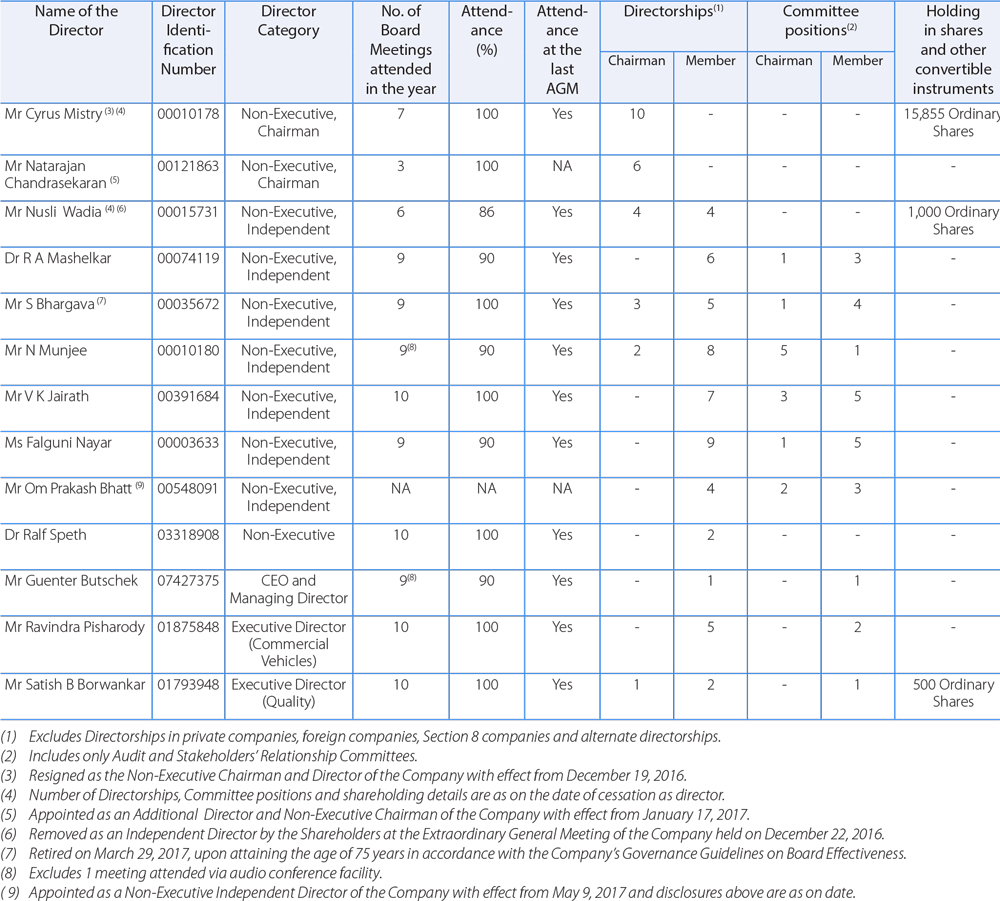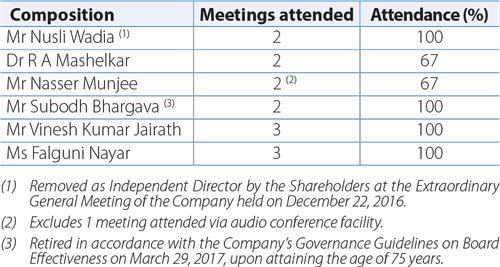COMPANY'S PHILOSOPHY ON CORPORATE GOVERNANCE
As a Tata Company, the Company's philosophy on Corporate Governance is founded upon a rich legacy of fair, ethical and transparent governance practices, many of which were in place even before they were mandated by adopting the highest standards of professionalism, honesty, integrity and ethical behavior. As a global organization, the Corporate Governance practices followed by the Company and its subsidiaries are compatible with international standards and best practices. Through the Governance mechanism in the Company, the Board along with its Committees undertakes its fiduciary responsibilities to all its stakeholders by ensuring transparency, fairplay and independence in its decision making.
The Corporate Governance philosophy is further strengthened with the adherence to the Tata Business Excellence Model as a means to drive excellence and the Balanced Scorecard methodology for tracking progress on long term strategic objectives. The Tata Code of Conduct, which articulates the values, ethics and business principles, serves as a guide to the Company, its directors and employees is supplemented with an appropriate mechanism to report any concern pertaining to non-adherence to the said Code. The Company is in full compliance with the requirements of Corporate Governance under the Securities and Exchange Board of India (Listing Obligations and Disclosure Requirements) Regulations, 2015 ("SEBI Listing Regulations"). The Company's Depositary Programme is listed on the New York Stock Exchange and the Company also complies with US regulations as applicable to Foreign Private Issuers (non-US companies listed on US Exchange) which cast upon the Board of Directors and the Audit Committee, onerous responsibilities to improve the Company's operating efficiencies. Risk management and the internal control process focus areas, continue to meet the progressive governance standards.
The Company has adopted Governance Guidelines on Board Effectiveness based on current and emerging best practices from both within and outside the Tata Group of companies.
BOARD OF DIRECTORS
The Board of Directors along with its Committees provide leadership and guidance to the Company's management as also direct, supervise and control the performance of the Company. The Board currently comprises of 10 Directors out of which 7 Directors (70%) are Non-Executive Directors. As at March 31, 2017 the Company has a Non-Executive Chairman and 4 Independent Directors consequent to the retirement of Mr Subodh Bhargava, an Independent Director on March 29, 2017. The Company appointed Mr Om Prakash Bhatt on May 9, 2017 and presently the Independent Directors comprise more than half of the total strength of the Board. All the Independent Directors have confirmed that they meet the 'independence' criteria as mentioned under Regulation 16(1)(b) of the SEBI Listing Regulations and Section 149 of the Companies Act, 2013 ("Act").
All the Directors have made necessary disclosures regarding their directorships as required under Section 184 of the Act and on the Committee positions held by them in other companies. None of the Directors on the Company's Board hold the office of Director in more than 20 companies, including 10 public companies and none of the Directors of the Company are related to each other. In accordance with Regulation 26 of the SEBI Listing Regulations none of the Directors are members in more than 10 committees or act as chairperson of more than 5 committees [the committees being, Audit Committee and Stakeholders' Relationship Committee] across all listed entities in which he/she is a Director. All Non-Executive, Non Independent Directors, are liable to retire by rotation. The appointment of the Managing Director and Executive Directors, including the tenure and terms of remuneration are also approved by the members at the first meeting after the said appointment.
The required information, including information as enumerated in Regulation 17(7) read together with Part A of Schedule II of the SEBI Listing Regulations is made available to the Board of Directors, for discussions and consideration at Board Meetings. The Board reviews the declaration made by the CEO & Managing Director and the Group Chief Financial Officer ("CFO") regarding compliance with all applicable laws on a quarterly basis, as also steps taken to remediate instances of non-compliance, if any.
Pursuant to Regulation 27(2) of the SEBI Listing Regulations, the Company also submits a quarterly compliance report on Corporate Governance to the Indian Stock Exchanges including details on all material transactions with related parties, within 15 days from the close of every quarter. The CEO & Managing Director and the CFO have certified to the Board on inter alia, the accuracy of the financial statements and adequacy of internal controls for financial reporting, in accordance with Regulation 17(8) read together with Part B of Schedule II of the SEBI Listing Regulations, pertaining to CEO and CFO certification for the Financial Year ended March 31, 2017. During the year under review, 10 Board Meetings were held on May 30, 2016, August 6, 2016, August 26, 2016, October 5, 2016, November 14, 2016 November 23, 2016, December 12, 2016, January 24, 2017, February 14, 2017 and March 30, 2017. The maximum time-gap between any two consecutive meetings did not exceed 120 days. All the agenda papers for the Board and Committee meetings are disseminated electronically on a real-time basis, by uploading them on a secured online application, specifically designed for this purpose, thereby eliminating circulation of printed agenda papers. The composition of the Board, attendance at Board Meetings held during the Financial Year under review and at the last Annual General Meeting (AGM), number of directorships (including Tata Motors), memberships/chairmanships of the Board and Committees of public companies and their shareholding as at March 31, 2017 in the Company are as follows:

The Company actively uses the facility of video conferencing permitted under Section 173(2) of the Act read together with Rule 3 of the Companies (Meetings of Board and its Powers) Rules, 2014, thereby saving resources – cost to the Company and valued time of the Directors.
Independent Directors' Meeting: As per Regulation 25(1) of the SEBI Listing Regulations, none of the Independent Directors serves as Independent Directors in more than 7 listed entities and in case of whole-time directors in any listed entity, then they do not serve as Independent Directors in more than 3 listed entities. During the year 3 Meetings of Independent Directors were held on November 14, 2016, December 12, 2016 and March 30, 2017, the attendance whereat is as follows:

An Independent Directors meeting in accordance with the provisions of Section 149(8) read with Schedule IV of the Act and Regulation 25(3) and 25(4) of the SEBI Listing Regulations was convened on March 30, 2017, to review the performance of the Non-Independent Non-Executive Directors including the Chairman of the Board and performance of the Board as a whole.
Board Effectiveness Evaluation: Pursuant to provisions of Regulation 17(10) of the SEBI Listing Regulations and the provisions of the Act, Board evaluation involving evaluation of the Board of Directors, its Committees and individual Directors, including the role of the Board Chairman, was conducted during the year. For details pertaining to the same kindly refer to the Board's Report.
Familiarisation Programme: Kindly refer to the Company's website for details of the familiarisation programme for Independent Directors on their roles, rights, responsibilities in the Company, nature of the industry in which the Company operates, business model of the Company and related matters.
COMMITTEES OF THE BOARD
The Board has constituted a set of Committees with specific terms of reference/scope to focus effectively on the issues and ensure expedient resolution of diverse matters. The Committees operate as empowered agents of the Board as per their Charter/terms of reference. Targets set/actions directed by them as agreed with the management are reviewed periodically and mid-course corrections are also carried out. The Board of Directors and the Committees also take decisions by circular resolutions which are noted at the next meeting. The minutes of the meetings of all Committees of the Board are placed before the Board for discussions/noting. An Organisation Chart depicting the relationship between the Board of Directors, the Committees and the senior management functions as at March 31, 2017 is illustrated below:
